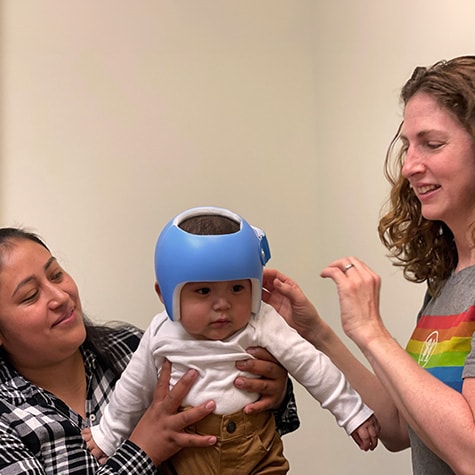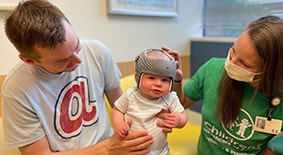How to Prevent a Flat Head in Babies
Back-sleeping is safest for infants, but it may put them at risk of developing a flat head. Learn how to protect your newborn’s delicate skull with these simple measures.
If you’ve ever pulled a snug onesie over a newborn baby’s head, you know how impossibly soft those little skulls are.
It’s no surprise that putting a newborn to sleep on their back—an absolute must to prevent sudden infant death syndrome (SIDS)—can lead to skull flatness over time. Also known as plagiocephaly, flat head syndrome is common (a 2013 study found that almost half of all 2-month-olds have it) but is often preventable with a few good habits. And unlike SIDS, it’s not life-threatening.

What causes a baby to have a flat head or skull flatness?
Skull flatness, called plagiocephaly, may occur when a baby develops a flat spot on the back or side of the head. When the flattened area is mostly straight across the back of the head, it’s known as brachycephaly.
Because newborns spend most of their days (and if you’re lucky, nights) snoozing on their backs, their soft skulls easily compress if left in the same position for too long. “Cushy car seats, swings and rockers can actually cause more flattening than a firm crib mattress, as the latter lets the baby turn their head more easily,” says Jessica Corso, CO, FAAOP, orthotist and lead of the Cranial Remolding Program at Children’s.
A flat spot can also develop due to muscle tightness on one side of the neck, a condition called torticollis. Torticollis causes a baby to favor turning or tilting their head to one side more than the other, which can lead to other developmental asymmetries along with a flat head.
There are several intrauterine causes that may lead to infants being born with skull flatness, especially if the baby has a twin or is a triplet.
During regular well-baby visits, your child’s pediatrician should check the shape of their head to see if there’s an area where less hair is growing or where the skull looks lopsided or flat. You should also watch for those signs of plagiocephaly or brachycephaly yourself.
Avoiding a flat head in infants is all about changing their positioning. Make the following five techniques part of your baby’s routine:
-
Up the tummy time. Tummy time is any activity that keeps your baby off their back. It’s essential for avoiding and improving flat spots while also developing the neck and shoulder muscles and other muscles needed to roll, sit and crawl.
Most babies aren’t big fans of tummy time at first, and as a result some parents are tempted to skip it. Don’t: Tummy time is very important for their development. Start with small doses (a couple of times a day for three to five minutes at a time), building up to 20 to 30 minutes throughout the day. Support their chest with a pillow or rolled-up blanket until they're strong enough to support themself. - Limit time in car seats, rockers and other equipment. Along with tummy time, this is probably the biggest tip for avoiding a flat head. Using carriers and seats for long stretches—whether your baby is sleeping or awake—restricts your baby’s head movement. Move them to different positions and locations throughout the day—yes, even if that means transferring a slumbering baby from car seat to crib (painful for mom and dad, helpful for a round skull).
- Change up your baby’s position in the crib. Make no mistake, you should always place your baby on their back. Infants who are placed on their stomachs to sleep have double the risk of SIDS. It’s all right if your baby rolls over into other positions, and you don’t need to rearrange them if that happens; just don’t start them on their stomach, and be mindful of other safe sleep tips. When putting your baby in their crib, alternate placing their head at the head and foot of the crib. Your baby will naturally look out into the room, so switching ends of the crib will encourage them to turn their head both ways.
- Change up your baby’s feeding position. You might have a preferred position for breastfeeding or a favorite arm for bottle feeding. Mix it up to alternate which way they turn to look at you. Bottle feeders can also try an arms-free version: Sit with your back supported, knees bent and your baby on your legs facing you.
- Carry your baby in different ways. Switching shoulders and hips to carry your baby helps them turn both ways to look out at the world. Tote their belly down across your arm for support (sometimes called “the football hold”), or carry them facing out to let them take in the scenery from all angles. Just be sure to give their head and neck the support they need. When you need to be hands-free, slings and wearable baby carriers are great alternatives to putting the baby on their back in a rocker or swing.
Don’t panic. Plagiocephaly or brachycephaly won’t hurt your baby’s brain development, and it’s usually temporary if you use the repositioning tips outlined above. The best time to correct the shape of your infant’s head through repositioning is during their first few months, when their skull is growing quickly.
If a few months of repositioning doesn’t improve the shape of their head, your pediatrician may recommend a cranial remolding orthosis, also called a helmet or a band.
The specialized clinicians in our Cranial Remolding Program can help determine if a helmet is right for them or if continued repositioning, tummy time and—in some cases—physical therapy will allow the baby to self-correct. Our cranial specialists are all board-certified and Georgia-licensed orthotists and prosthetists and are working to set the standard in cranial remolding care.

Supporting parents with accessible evaluations
Children's performs evaluations and initial scans for flat head syndrome at no cost, and most insurance plans are accepted. We have seven locations across metro Atlanta for assessment and treatment.
Find a LocationThis content is general information and is not specific medical advice. Always consult with a doctor or healthcare provider if you have any questions or concerns about the health of a child. In case of an urgent concern or emergency, call 911 or go to the nearest emergency department right away. Some physicians and affiliated healthcare professionals on the Children’s Healthcare of Atlanta team are independent providers and are not our employees.
Contact Us 404-785-3229



